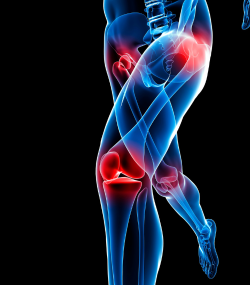
Joint Preservation
The Northwestern Medicine Hip and Knee Joint Preservation Center offers surgical and nonsurgical options for preserving a deteriorating joint to delay or avoid joint replacement surgery.
What is Joint Preservation?
Your hip and knee joints undergo heavy use throughout your life and play and key role in your movement. If these joints become injured or worn over time, you are more likely to notice symptoms. Even if an injury is minor, it can lead to a premature loss of cartilage in the joint as you age.
Hip and knee joint replacement are among the most common medical procedures performed in the United States today. The two most common groups of people who undergo surgery for hip and knee conditions are elderly adults with end-stage arthritis that requires joint replacement, and young athletes with a ligament or cartilage injury.
Alternative to joint replacement
Patients between the ages of 25 and 45 may have slowly degenerating joints, and they may not get the medical care they need to preserve their joints. When these patients do seek care, they may end up getting total joint replacement sooner in life than desired.
That’s why Northwestern Medicine Orthopaedics has established the Northwestern Medicine Hip and Knee Joint Preservation Center. Our multidisciplinary team of specialists offers joint preservation techniques that can help keep adults and adolescents with pre-arthritic conditions as functionally normal as possible.
Meet the Team

Physicians at the Northwestern Medicine Hip and Knee Joint Preservation Center specialize in surgical and nonsurgical options for preserving a deteriorating joint.
Meet the Northwestern Medicine Hip and Knee Joint Preservation Center team
Conditions
- Acetabular Dysplasia
- Arthritis
- Articular Cartilage Injuries of the Knee
- Articular Cartilage of the Hip
- Cam Impingement
- Femoroacetabular Impingement
- Gluteus Medius Tear
- Hip Abductor Tendon Tear
- Hip Impingement
- Hip Instability
- Hip Pain
- Knee Cartilage Defect
- Knee Pain
- Knee Problems
- Labral Hip Tear
- Loose Bodies in Hip
- Osteochondritis Dissecans
- Osteoporosis
- Patellar Instability
- Persistent Pain After Previous Hip Arthroscopy
- Pincer Impingement
- Snapping Hip
- Synovial Chondromatosis
- Trochanteric Bursitis
- Valgus Malalignment
- Varus Malalignment
Treatments
- Arthroscopic Debridement
- Cartilage Restoration
- Ganz Osteotomy
- Gluteus Medius Repair
- Hip Arthroscopy – Capsular Repair and Plication
- Hip Arthroscopy – Microfracture
- Hip Arthroscopy – Removing Loose Bodies
- Hip Arthroscopy Post-operative Rehabilitation Program
- Hip Injury Repair – Nonsurgical Treatment
- Knee Osteotomy Technique
- Labral Reconstruction – Hip
- Labral Repair – Shoulder
- Lower Extremity Osteotomy Techniques
- Matrix-Induced Autologous Chondrocyte Implantation
- Orthobiologic Therapy
- Osteochondral Allograft Transplantation
- Osteochondral Autograft Transfer
- Pelvic Osteotomy Techniques
- Periacetabular Osteotomy (PAO)
- Revision Hip Arthroscopy


